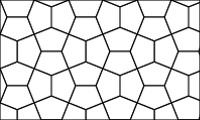 Top view (top) and side view (bottom) of penta-graphane. Yellow and blue spheres show two types of carbon atoms, while red balls correspond to hydrogens.[1]
| |
| Names | |
|---|---|
| Other names
PG
| |
| Identifiers | |
| Properties | |
| Cn | |
Except where otherwise noted, data are given for materials in their standard state (at 25 °C [77 °F], 100 kPa).
| |
Penta-graphene is a hypothetical carbon allotrope composed entirely of carbon pentagons and resembling the Cairo pentagonal tiling.[2] Penta-graphene was proposed in 2014 on the basis of analyses and simulations.[2] Further calculations predicted that it is unstable in its pure form,[3] but can be stabilized by hydrogenation.[1] Due to its atomic configuration, penta-graphene has an unusually negative Poisson’s ratio and very high ideal strength believed to exceed that of a similar material, graphene.[2]

Penta-graphene contains both sp2 and sp3 hybridized carbon atoms. Contrary to graphene, which is a good conductor of electricity, penta-graphene is predicted to be an insulator with an indirect band gap of 4.1–4.3 eV. Its hydrogenated form is called penta-graphane. It has a diamond-like structure with sp3 and no sp2 bonds, and therefore a wider band gap (ca. 5.8 eV) than penta-graphene.[1] Chiral penta-graphene nanotubes have also been studied as metastable allotropes of carbon.[4][2][5]
References[edit]
- ^ a b c Einollahzadeh, Hamideh; Fazeli, Seyed Mahdi; Dariani, Reza Sabet (2016). "Studying the electronic and phononic structure of penta-graphane". Science and Technology of Advanced Materials. 17 (1): 610–617. arXiv:1511.06850. Bibcode:2016STAdM..17..610E. doi:10.1080/14686996.2016.1219970. PMC 5102001. PMID 27877907.
- ^ a b c d Zhang, S.; Zhou, J.; Wang, Q.; Chen, X.; Kawazoe, Y.; Jena, P. (2015). "Penta-graphene: A new carbon allotrope". Proceedings of the National Academy of Sciences. 112 (8): 2372–2377. Bibcode:2015PNAS..112.2372Z. doi:10.1073/pnas.1416591112. PMC 4345574. PMID 25646451.
- ^ Ewels, Christopher P.; Rocquefelte, Xavier; Kroto, Harold W.; Rayson, Mark J.; Briddon, Patrick R.; Heggie, Malcolm I. (2015). "Predicting experimentally stable allotropes: Instability of penta-graphene". Proceedings of the National Academy of Sciences. 112 (51): 15609–12. Bibcode:2015PNAS..11215609E. doi:10.1073/pnas.1520402112. PMC 4697406. PMID 26644554.
- ^ Quijano-Briones, JJ.; Fernandez_escamilla, HN; Tlahuice-Flores, Alfredo. (2017). "Chiral penta-graphene nanotubes: Structure, bonding and electronic properties". Computational and Theoretical Chemistry. 1108: 70–75. doi:10.1016/j.comptc.2017.03.019.
- ^ Avramov, P; Demin, V; Luo, M (2015). "Translation Symmetry Breakdown in Low-Dimensional Lattices of Pentagonal Rings". J. Phys. Chem. Lett. 6 (22): 4525–4531. doi:10.1021/acs.jpclett.5b02309. PMID 26582476.
External links[edit]
- Nazir, Muhammad Azhar; Hassan, Arzoo; Shen, Yiheng; Wang, Qian (2022). "Research progress on penta-graphene and its related materials: Properties and applications". Nano Today. 44: 101501. doi:10.1016/j.nantod.2022.101501. S2CID 248767647.